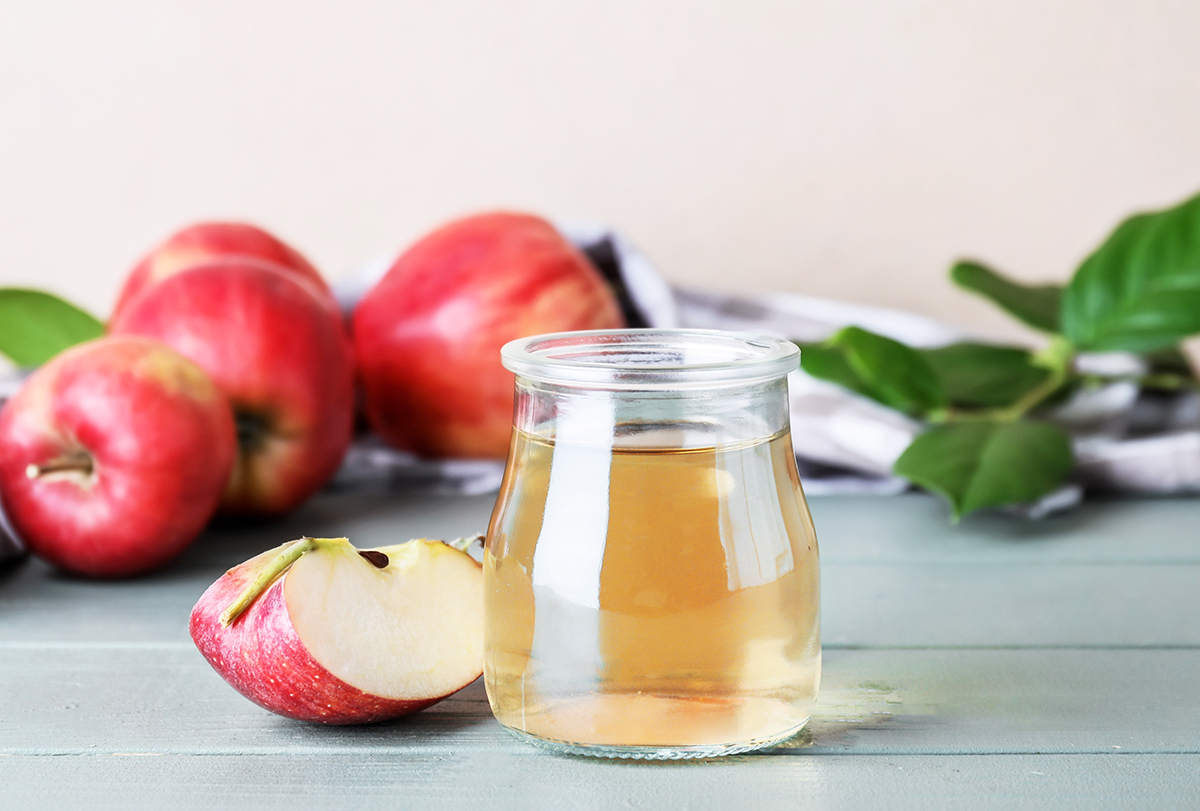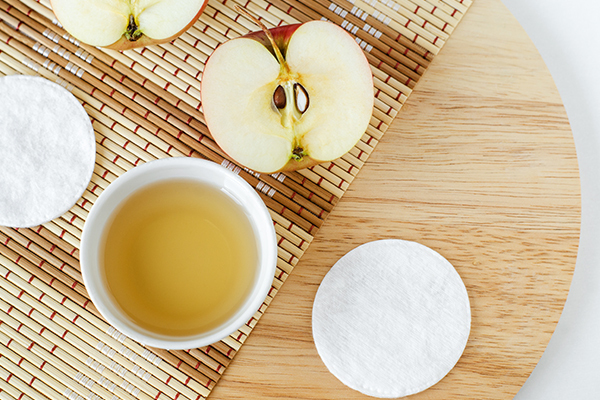
Apple cider vinegar (ACV) is a common kitchen ingredient that can do much more than just add flavor to your food. It is also widely used as a home remedy for a variety of dermatological ailments, particularly acne.

The acne-fighting action of ACV can be attributed to the acids, nutrients, and other beneficial compounds found in it. (1)
For starters, ACV is loaded with good bacteria that help keep the harmful acne-causing bacteria in check to reduce breakouts. This is further aided by the presence of multiple natural acids that help kill germs, soak up excess sebum, and gently exfoliate the skin, all of which lead to better acne control.
Plus, ACV also helps lighten acne scarring by facilitating the easy removal of the damaged outer layer of the skin.
Due to its mild acidic nature, ACV dissolves the dead cells accumulated on the surface of the skin so that they shed quickly, revealing fresh healthy skin underneath. This helps fade the acne marks over time while evening out your overall skin tone. (2)
ACV is also enriched with vitamins, enzymes, and mineral salts that help nourish and repair your skin. It also helps balance your skin’s pH to render it inhospitable for the growth of acne bacteria.
Disclaimer:
- ACV is a weak acid, but an acid nevertheless. So, excessive topical use can irritate or damage the skin and should be avoided.
- ACV can adversely interact with the medications you are using, so it’s best to consult your doctor before trying ACV remedies.
- Patch test the remedy on the back of your palm or underside of your forearm before applying it to your face. This will help you determine your skin’s tolerance for ACV and rule out any adverse or allergic reactions. If you notice skin irritation after applying the remedy, wash it off with cool water, and stop its use.
- Do not apply ACV on open sores or broken skin.
How to Use ACV for Acne Control
Here are some easy ways of using ACV for controlling acne breakouts:
1. Toner

ACV can be used as a natural astringent to clear the excess sebum from the skin, tighten your pores, and restore healthy skin pH.
How to use:
- Mix equal parts of raw, unfiltered ACV and filtered water in a bowl. If you have sensitive skin, add more water to reduce the acidic potency of ACV.
- Dip a cotton ball in the mixture and dab it on the affected skin.
- Let it sit for 10 minutes before rinsing it off with lukewarm water.
- Apply a moisturizer while your skin is still slightly damp.
- Repeat this procedure one or two times daily for a few days to see results.
2. Spot treatment
ACV can help shrink your acne pimples and fade your acne marks rapidly. The best way to do so is by applying the following ACV remedies specifically to the lesion or scar, rather than to the whole face.
This localized application is called spot treatment, and it works by concentrating the acne-fighting ingredients on the infected area, resulting in speedy healing.
How to use:
- Dip a Q-tip or cotton swab in ACV.
- Dab it on your acne zits, spots, or blemishes.
- Do this every day until your skin clears.
3. ACV face wash
You can also mix ACV with your regular face wash to enhance its skin-cleansing effect. The acidic nature of ACV gives your face wash a mild exfoliating effect.
ACV penetrates deep into your pores to dislodge the dirt, sebum, and dead skin cells settled inside. This type of deep skin cleansing curbs the growth of acne-causing bacteria on the skin and thereby reduces breakouts.
How to use:
- Mix 1 teaspoon of ACV with your face wash.
- Massage the mixture all over your face with clean fingers using light circular motions.
- Rinse as usual.
4. DIY acne-control face mask
You can combine ACV with other skin-friendly ingredients to whip up an acne-control face mask that also functions as a gentle scrub.
How to use:
Method 1

- In a clean bowl, mix 1 tablespoon of gram flour, 1 teaspoon of honey, 1 tablespoon of ACV, and 1 teaspoon of rose water to make a paste.
- Apply this mask to your face, except the delicate area around your eyes to avoid irritation.
- Let it sit for 15 minutes.
- Wet your hands or splash some water on your face and gently scrub the paste in circular motions for 2–3 minutes.
- Wash it off with normal water.
Method 2
- Mix 1 teaspoon of activated charcoal, 1 teaspoon of bentonite clay, and some ACV to make a thick paste.
- Apply this paste to your face and leave it on for 15–20 minutes.
- Once it dries, splash some water on your face to loosen the mask, and then gently scrub it in light circular motions for a few minutes.
- Wash it off with cool water.
- Moisturize while your skin is still damp.
5. Scar treatment
ACV can help reduce acne scarring through its exfoliating and skin-brightening effects.
How to use:
- Combine one part ACV, one part water, and a bit of honey.
- Apply this mixture to your acne scars.
- Leave it on for 20–30 minutes.
- Rinse it off with normal water.
- Do this once daily until the scar goes away.
Side Effects of ACV Usage
The main component of ACV is acetic acid, which in concentrated amounts can inflame, irritate, or corrode the skin, (3) although its concentration in ACV is generally considered safe for topical use.
However, applying it too much or too frequently can still damage the skin. Plus, it’s always better to mix ACV with water or other ingredients to weaken its potency.
Additional Skin Care Tips for Acne Control

Follow these simple measures to minimize acne breakouts:
- Follow a stringent skin care routine, with proper cleansing and moisturizing as the most basic steps. You can also ask your dermatologist to recommend other skin actives that can help fight acne and repair your skin.
- If you have acne-prone skin, only use non-comedogenic skin care products and cosmetics as they won’t clog your pores. (4)
- Never go to bed with makeup on as it can clog your pores overnight and trigger breakouts. It’s recommended not to use makeup when you have an active breakout.
- Scrubbing your active acne lesions can make them pop and spread the infection, making the surrounding skin worse.
- Rinse with lukewarm water.
- Consume a well-balanced nutritious diet to nourish your skin from within.
- Maintain proper fluid intake to keep your skin hydrated and flush out the harmful toxins. (5) Dry skin overproduces oil, which can clog your pores and trigger acne breakouts.
- Don’t squeeze or pick at your pimples as you may spread the infection to the surrounding skin and also cause deep tissue damage that leaves behind a permanent scar.
- Wear sunscreen when going outdoors.
- Manage your stress levels by taking up relaxation therapies, yoga, meditation, etc.
How Long Does It Take for Apple Cider Vinegar to Work on Acne?

ACV is not a magic ingredient that will make your acne disappear overnight. It does have beneficial properties, but they take some time to show effect.
ACV works by gently exfoliating the damaged outer layer of the skin, allowing fresh layers to rise to the top.
This skin renewal process occurs gradually, and it takes about 4–6 weeks for the entire top layer to shed and be replaced. So, you may have to wait for this entire skin regeneration cycle to complete to see visible results.
Final Word
Acne is the leading skin complaint reported in the USA and affects nearly 80% of the population at some point in their life. It is often caused by the buildup of excess sebum, dirt, and cellular debris inside the skin pores, which causes clogging.
Your skin is home to certain staphylococcus bacteria that feed on this organic matter and multiply rapidly to cause an infection. The infection, in turn, triggers inflammation in the affected skin, leading to the appearance of acne pimples.
ACV is credited with strong anti-inflammatory properties that help relieve the pain, swelling, and redness associated with these lesions. Plus, it helps control the infection by killing the bacteria causing it.
When used properly, this simple ingredient can help reduce the frequency and severity of acne breakouts. Just bear in mind that this remedy is mainly recommended as an adjunct measure for mild acne.







